
Fax: (860) 430-9693
Glastonbury, CT 06033

At least 80% of people in the U.S. will experience an episode of low back pain at least once in their lives. Approximately 15% of these episodes will progress to chronic back pain. Books and volumes have been written about low back pain, and a complete discussion is beyond the scope of this page. But we would like to present you with some facts and ideas that you may not hear anywhere else. The low back gets its stability from several structures—the bones and joints, the intervertebral discs, the ligaments, and the muscles. We offer options for treating low back pain in Glastonbury, CT at Valley Sports Physicians & Orthopedic Medicine.
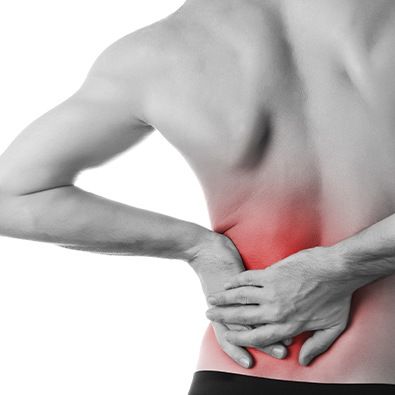
The bones and joints form the building blocks of the spine. The joints of the low back are called the facet joints. They are the small joints located on the back of the spinal column. Compression fractures of the vertebral bodies, arthritis of the facet joints, surgery that removes facet joints (such as a laminectomy), and fractures or congenital abnormalities of the portion of bone between the facet joints (called the “pars interarticularis”), causing a “spondylolysis,” all can disrupt the stability of the bony spine.
Under normal conditions in the healthy spine, the facet joints bear about 25% of the axial load of the spine, and the discs bear the remaining 75%. When the discs start to wear out, more of the load is shifted to the facet joints, which causes premature wear, arthritis, and subsequent instability and pain. Arthritic change in the facet joints is known as degenerative joint disease.
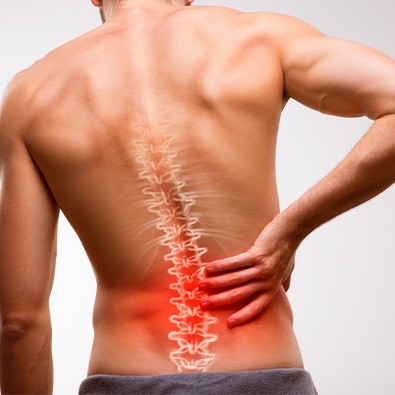
The discs act as shock absorbers between the vertebrae. The disc is a fluid-filled structure, with a thick fibrous outer ring, called the annulus, surrounding a gelatin-like center, called the nucleus pulposus. The discs are firmly attached to the vertebrae above and below. There is, therefore, no such thing as a “slipped disc.”
Like a water balloon when you squeeze it, discs bulge under pressure or load. They’re supposed to do this! This is how they help cushion the bones. In other words, disc bulging is normal. Problems occur when they bulge too much, thereby stretching the outer fibrous ring and irritating the attached nerves.
Over time, the fluid inside the discs begins to diminish, and the disc undergoes “degeneration,” a type of wear and tear. Again, this is normal. However, sometimes excessive physical or sports activities, injuries to the disc, and genetic factors can cause a disc to wear out prematurely. This is known as degenerative disc disease.
It used to be thought that degenerative discs did not cause pain. But recent research is questioning this, and some researchers believe that as the disc breaks down, occasionally it leaks out inflammatory chemicals that irritate surrounding nerves and ligaments and cause pain.
A herniated disc occurs when a tear develops in the outer ring of the disc (the annulus), allowing some of the gelatin-like nucleus to squirt out. This puts pressure on the nerve exiting the spine and causes symptoms of sciatica. Often a disc develops tears in the annulus, and this allows inflammatory enzymes to leak out, irritate the adjacent nerves and ligaments, and cause pain. This is called an annular tear or fissure. These tears are often missed on MRI studies.
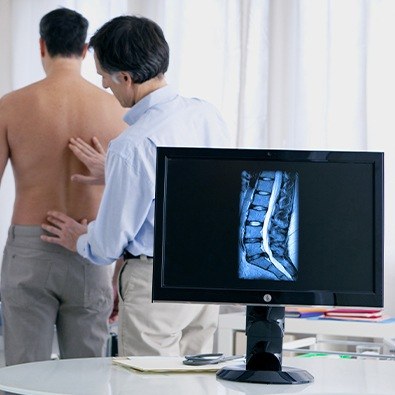
Patients often ask that an MRI be performed to look for disc problems. The problem is that not all disc pathology causes pain. A study published in 1994 in the New England Journal of Medicine performed MRIs on almost 100 people with no history of back pain (Jensen et al. N Engl J Med. 1994;331:115-116). 64% of these “normal” people had at least one abnormal disc—52% had bulging discs, 27% had disc protrusion, and 1% had a frankly herniated disc. 38% of the subjects had more than one abnormal disc. But none of them had any pain! MRIs and CT scans can show disc abnormalities, but they cannot tell whether a disc is causing pain.
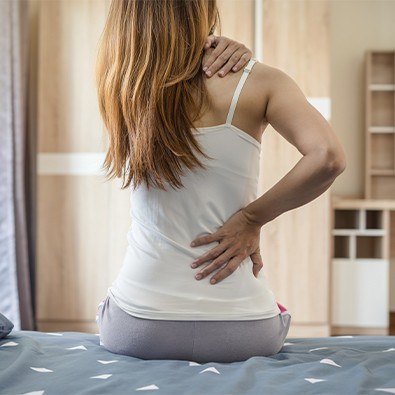
Ligaments connect bone to bone. They help hold the joints together. They are the “guy wires” that limit and control motion. They also have a strong nerve supply, which is why it hurts so much when you sprain something. Damage to a ligament is called a sprain.
The ligaments of the low back help stabilize the low back joints. The ligaments are damaged in several ways. Lifting an item improperly, bending and twisting (such as shoveling snow or reaching into the trunk of your car), childbirth, or repetitive strain over time all can injure them. When a ligament is damaged, spine stability can become compromised, occasionally leading to slightly increased motion in the joints.
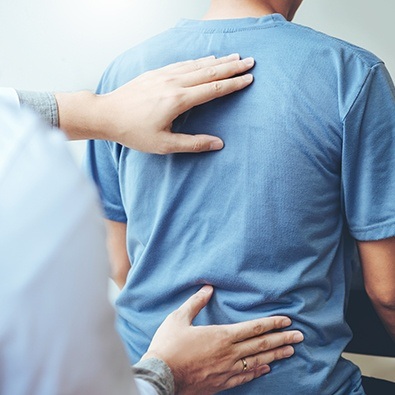
The muscles of the low back are critical for support, stability, and movement. In fact, a human spine, with all of the muscles stripped away (leaving only the ligaments) will collapse under only five pounds of force! Strong muscles help take the stress off the discs, joints, and ligaments. In addition, strong muscles provide the endurance to perform physically demanding tasks throughout the day. Think of the muscles as additional “shock absorbers” of the spine. The multifidus and quadratus lumborum muscles are particularly prone to causing low back pain.
The muscles of the low back work in close conjunction with the muscles of the buttocks, abs, and legs to provide stability for the low back. This coordinated muscle activation is so closely intertwined that, when one muscle is not working properly, other muscles will begin to work harder to compensate for it, leading to pain.
Trigger points are small focal areas of muscle irritability. The pain from trigger points can be either local or it can refer to other areas. It can be steady or intermittent, dull and aching, often deep. It may occur at rest, or only with movement. It varies from being a low-grade discomfort to severe and incapacitating. Also, the pain from trigger points can mimic other causes of pain, occasionally leading to wrong diagnoses and unnecessary treatment.
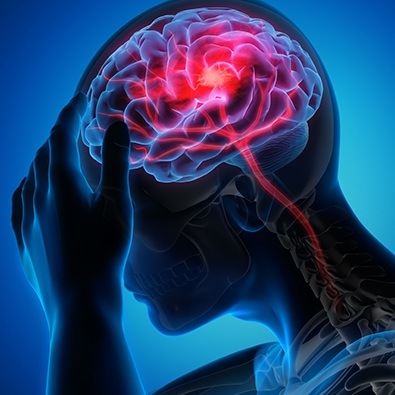
The brain is actually the most important “pain” structure in the body. It is our brain that interprets the various nerve signals as “pain” and then tells us how to react or respond to them. Dr. Tortland recalls one patient who had chronic back pain that failed to respond to all treatments—physical therapy, manipulation, injections, medication—and eventually she went her way. Several months later Dr. Tortland met her in the grocery store, and she told him that her back pain completely disappeared one week after she quit her job!
While not all back pain is due to stress, stress and psychological factors certainly can play a role in back pain. In addition, as noted above, the brain and central nervous system can become sensitized in the face of chronic pain, resulting in persistent pain processing, even long after the original injury heals.
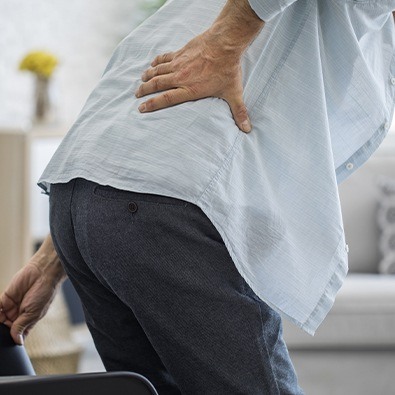
There are multiple ways to diagnosis the source of lower back pain:
The single greatest tool in diagnosing LBP is the History and Physical Exam . How/when the pain started, where the pain is located and refers to, what makes it better/worse, what treatments have been attempted—all these are important to help understand potential causes of LBP. In many cases, a thorough history alone can point to a probable cause. The physical exam, of course, gives the doctor an opportunity to look for signs that may help indicate the source of the pain. An exam should be more than simply having you bend forward and checking your reflexes! If a doctor does not physically examine you— feel for tenderness, muscle spasm, trigger points, restricted range of motion, muscle firing patterns, etc.— it is an incomplete and substandard exam.
Special tests can be performed to help determine the cause of pain. These can be as simple as certain tests of movement done in the office, or more aggressive such as a Novocain injection to numb a suspected cause of pain, to tests that have to be done in a special facility. For example, to help determine whether a disc is causing pain, sometimes a discogram is done. Under x-ray guidance, fluid is injected directly into the suspected disc in an effort to reproduce the patient’s symptoms. If the identical symptoms develop, then the disc is likely the source of the pain. Your doctor will advise you as to what additional tests he/she thinks are appropriate.
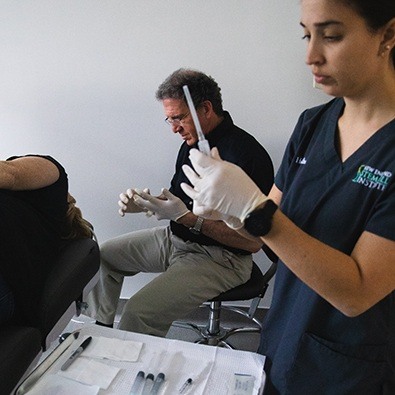
Entire texts have been written about treating LBP, but the following is an overview, including the approaches we use here at Valley Sports Physicians & Orthopedic Medicine.
Most often a combination of two or more different types of medications is used in order to take advantage of the different mechanisms of action. In addition, occasionally several different medications may be tried in order to find the one(s) that best help treat the pain. However, medication by itself is rarely the sole answer to treating pain . Medication most often is used to help reduce the pain so you can pursue other treatments, such as exercise and physical therapy.
In chronic low back pain, the goal of physical therapy is to improve function. In chronic pain, whether as a result of the original injury or as a result of muscular compensation, most people develop altered movement and muscle firing patterns. Some muscles become weak or inhibited, while other muscles become tight or over-activated. These altered muscle firing patterns lead to changes in motor control, which then helps perpetuate the chronic pain.
Physical therapy procedures such as hot packs, cold packs, ultrasound, and electrical stimulation may help you feel better in the very short term, but they do nothing to address the altered motor control problems. Furthermore, most physical therapy stretches, and exercises likewise not only most often do not address the motor control issues, but more often just reinforce the underlying muscle firing dysfunction. This is one of the reasons why many physical therapy programs do not help—or even sometimes aggravate—chronic back pain conditions.
There are two other problems with most traditional physical approaches to treating chronic pain. First, most therapy clinics do not allow enough one-on-one time between the patient and therapist. Many therapy clinics have the therapist treating more than one patient at a time in order to maximize revenue. Treating chronic pain requires at least 30 minutes, and preferably 45-50 minutes, of dedicated one-on-one time. Second, physical therapy for treating chronic back pain is best performed once every 1-3 weeks over a several month period, not 2-3 times a week for just a few weeks.
Most physical therapists, while well-meaning and sincere in their desire to help patients, are not properly trained in the rehabilitation techniques to identify and address the underlying neuromuscular firing abnormalities. The challenge is finding a well-trained therapist.
Manual treatment, such as Osteopathic Manipulative Treatment (OMT/OMM) or chiropractic treatment, can be a useful treatment as well. Rarely does this type of treatment cure chronic back pain. However, it can help improve and maintain mobility and help the other treatment approaches work more effectively. Be careful, though—manipulation treatments that are too frequent can actually worsen your condition by creating further instability. In our opinion, there really is no indication for manipulation treatment multiple times a week, and usually not more than one or a few times a month.
There are a number of injection therapies that may be tried for the treatment of chronic LBP.
As noted above, trigger points are small focal regions of muscle irritability that can cause local and referred pain. In addition, trigger points prevent the muscle from being stretched fully. When you try to stretch a muscle that has a trigger point in it, the stretching activates the trigger point, causing the muscle reflexively to tighten up. Trigger points are treated by injecting them with Novocain, then almost immediately, while the trigger point is still numb, stretching the muscle. Numbing the trigger temporarily inactivates it so you can then stretch the muscle more fully. If you do not stretch the muscle after doing the injection, you have almost wasted the injection. Many times trigger points need to be treated multiple times in order to “break” the cycle or pattern. If the triggers continue to return, however, then there is usually something else going on that is causing the triggers to form.
An “epidural” is an injection that delivers steroid medication (e.g., cortisone) directly into the epidural space in the spine. This is the space that surrounds the spinal canal and nerves. The cortisone typically is mixed with some anesthetic, such as lidocaine. There are often inflammatory factors and other substances that generate pain and are associated with a lumbar disc herniation, and this inflammation can cause significant nerve root irritation and swelling. Steroids (corticosteroids) have been shown to reduce inflammation by inhibiting the production of substances that cause inflammation. The epidural steroid injection can be highly effective because it delivers the medication directly to the site of inflammation.
Epidural injections can be used diagnostically as well as therapeutically. If the diagnosis or cause of the pain is unclear, particularly if there is a question about whether a disc is causing the pain, an epidural can be done. If there is significant pain relief, then it is more likely that the disc or disc-related structures are causing the pain, and further treatment can be directed accordingly.
Epidural injections are performed under special x-ray guidance by physicians properly trained in the procedure.
The facet joint is the small bony joint on either side of the vertebrae. Like all joints in the body, there is a nerve that innervates the joint. As noted above, the facet joint can be sprained or undergo arthritic change and cause pain. The nerve that innervates the facet joint can be numbed temporarily to see if there is pain relief. Like epidural injections, this is done under x-ray guidance.
Prolotherapy, PRP, and Stem Cell injections are special procedures designed to repair damaged ligaments, tendons, and even discs. If physical therapy and other conservative treatments don’t help, these treatments may be indicated. Even if you've had surgery and you're suffering from pain, there may be help! We've been performing these treatments longer than most in the entire country; few have our level of skill and experience. We've had excellent success over the years treating chronic LBP with Regenerative Medicine treatments. For a complete discussion on these treatments get our FREE Regenerative Medicine e-book .
(NOTE: All of our Regenerative Medicine procedures are performed by our affiliate, the New England Stem Cell Institute.)
Surgery may be indicated for certain herniated discs or disc-related problems. However, most studies indicate that over 90% of herniated discs do not require surgery. Fairly recent technological advances have made disc replacement surgery a reality for many patients, and a spine surgeon can advise you as to whether you may be a candidate for this. However, except for a few rare circumstances, surgery is almost always a last resort.
Many alternative therapies may be useful as part of a comprehensive treatment plan for chronic LBP. These can include:
Ask your regular or sports medicine doctor about the appropriateness of these for your particular condition.
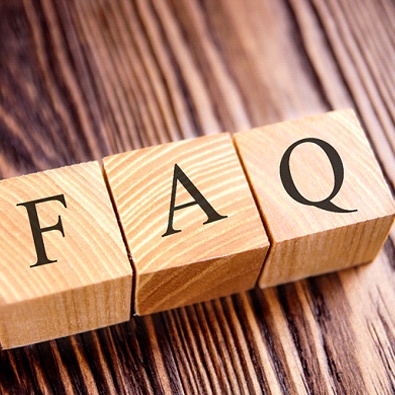
As you can imagine, we see a lot of patients suffering from low back pain, and they usually have a lot of questions. Dr. Tortland and the Valley Sports Physicians team pride ourselves on taking the time to provide any information a patient needs so they can enjoy peace of mind throughout the treatment process. Below, you’ll find some of the most common questions we receive about this subject as well as our responses.
The main factor that distinguishes our practice from other orthopedic offices and pain centers is our use of ultrasound and regenerative medicine (through our affiliate practice, the New England Stem Cell Institute). Ultrasound allows us to examine the various structures of the back beneath the skin while it is in motion, unlike other imaging techniques, which can help us identify what is causing a problem with extreme precision. Then, we can apply regenerative medicine, such as PRP, prolotherapy, or stem cell therapy, using ultrasound-guided injections so that the treatment is being placed exactly where it is needed to ensure the best result.
Many patients turn to surgery believing it will be the “ultimate solution” for their lower back pain, only to find themselves back in the doctor’s office soon after. We’re able to work with patients no matter what other treatments they are currently undergoing or have already completed. Dr. Tortland can work with a patient’s primary doctor, and most of the techniques he uses are non-invasive, meaning they are easy to implement into someone’s care plan without undoing previous progress or requiring a patient to interrupt their life.
The answer to this question relies heavily on an individual’s situation. Minor back pain where the cause is readily apparent can often be resolved in a few visits, but for more complicated cases and severe pain, finding the root of the problem, determining the right treatment, and implementing care may take months, leading to a greater cost.
Different treatments incur varying costs as well. For example, prolotherapy is very affordable, but it may take weeks or months of injections before a patient sees results. On the other hand, stem cell therapy often helps a patient heal relatively quickly, but it is notably more expensive.
One of the best things you can do is keep a pain journal about a week or so ahead of your first visit with Dr. Tortland. Try to note when you feel pain, how severe it is, what you were doing when it started, etc. This will allow Dr. Tortland to better understand your condition and potentially notice trends that could point him toward a diagnosis.
After you begin treatment with him, all you need to do is simply follow his instructions, which may involve taking pain medication as directed, maintaining regular appointments, and completing exercises/stretches as recommended to improve your back’s mobility and strength.